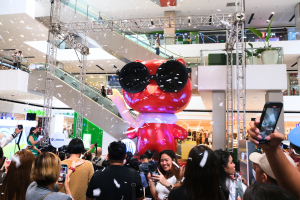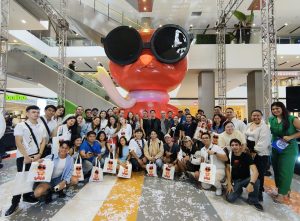
It was the first Mexican event I attended in Davao City since 2014. I still remember clearly that it was in September of that year when no less than H. E. Ambassador of Mexico to the Philippines Julio Camarena-Villasenor came to Davao to host a special event called “Mexican Night” held at the Ballroom of the Marco Polo Davao. Last June 10, 2019, H.E. Mexican Ambassador Gerardo Lozano Arredondo, who was dressed in his country’s traditional guyabera (which could pass for our polo barong), headed straight to the Philippine Women’s College of Davao upon his arrival. The Mexican Ambassador wanted to check for himself on the strong “similarities of Mindanao’s indigenous tribes’ textile patterns with those of his Native Mexicans’ traditional fabrics particularly those produced by the Yucatan tribe.” Ambassador Lozano was ably accompanied and assisted by the respected and always well-dressed Honorary Consul of Mexico in Mindanao, Dr. Maria Lourdes Garcia-Monteverde, and her devoted husband, Dr. Tomas Monteverde.
Warmly welcoming the Mexican Ambassador and his entourage to Davao’s Philippine Womens College’s Mindanao Folk Arts Museum and Artisanal Heritage Studies and Creative Centre were the institution’s department heads led by Vicente Antonio V. Pijano III, the Vice President for Institutional Development and Acting VP for the PWC Administration. The Museum has for its first ever exhibition “HeadPeace: the Tangkulo of the Bagobo-Tagabawa” which truly impressed the Mexican Ambassador. Prof. Emi Englis, who also acted as Master of Ceremony, did a good job as curator of the Museum explaining every detail of the objects on exhibit to Ambassador Lozano. Naturally, Emi’s Davao’s Fashion Designers Council led by Dodjie Batu and Aztec Barba were there in full support; and so was the iconic PWU figure, Ms. Brenda Barba.

A native of Mexico City, Mexican Ambassador Gerardo Lozano Arredondo has a distinguished career in the diplomatic service of Mexico. He has served as Director of Economic Affairs at the Embassy of Mexico in France, Deputy Representative of Mexico for the Organization for Economic Cooperation and Development, Director of Economics and Multilevel Affairs in the Permanent Mission of Mexico to the International Organization in Geneva, just to mention some. Ambassador Lozano earned his Bachelor’s degree in Economics from the National Autonomous University of Mexico; and a Master’s degree in National Security Planning from the Center for Advanced Naval Studies. As an economist, you’d be surprised to hear the good Ambassador professing the importance and significance of Culture and the Arts in keeping alive the Soul of the Nation.

“Mexico and the Philippines have shared history, traditions and customs dating back five centuries ago when our two countries were under the Spanish Crown. Ferdinand Magellan discovered and claimed the islands for the Spanish Crown in 1521 in the same year that Hernan Cortes conquered the Aztec Empire. Ruy Lopez, who sailed from Barra de Navidad, Jalisco, Mexico, to make the first exploratory travel (known as the Legazpi Expedition) to the islands was made possible through Mexican funding. Lopez later claimed and named the islands ‘Philippines’ after King Philip II of Spain,” informed the Mexican Ambassador.

Mexican Amb. Lozano with the diplomatic corps of DavaoBecause of the long distance from Spain, the Spanish Government assigned Manila’s administration and government to Virreinato de la Nueva Espana (Mexico’s name during the colonial times) for two-and-a-half centuries. Owing to this, Philippine Governors were Mexicans and the army recruited from Nueva Espana which resulted in a mix between Mexicans and Filipinos in race and culture. Trade between Asia and America materialized through the Acapulco-Manila Galleon Trade spanning the whole of the Pacific Ocean and lasting for 250 years from 1565 to 1815. Nueva Espana (Mexico) administered the Philippines until 1815 when Spain took direct control of the islands. Both Mexico and the Philippines were colonized by Spain for three centuries.

5. (l-r): Dr. Tomas & Consul Malou Monteverde, Amb. Lozano, Councilor Mabel Acosta, Vice Mayor Bernie Al-ag, Louis Bonguyan“Yes, many Mexicans settled in Manila such that 5% of Nahuati words entered the Filipinos’ main language. These words include tata(y), nana(y), atole, avocado, balsa, cacao, calabaza, camote, chico, chocolate, sayote, among others. To this day, the Philippine currency has the same name as that of the Mexican peso.”

Consul Joji I. Bian, Archt. Michael E. Dakudao, Tisay Torres with Davao’s Fashion Designers CouncilIn the evening, Ambassador Lozano and Hon. Consul Monteverde hosted a dinner party at the Ballroom of the Marco Polo Davao. Ambassador Lozano graciously welcomed Davao’s diplomatic corps and respected representatives from the various sectors of the Davao community. And yes, the famous Mexican tequila was served.
Viva Mexico!



